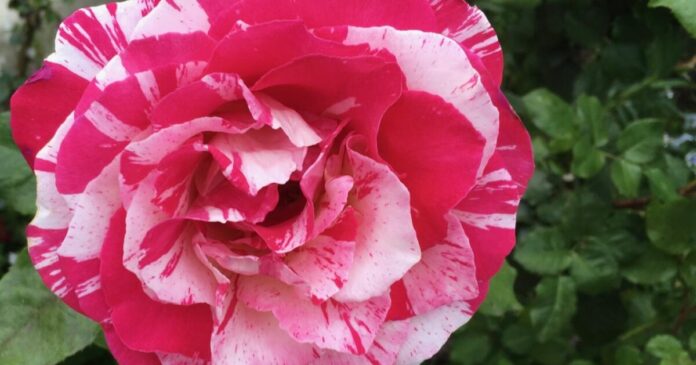Remember when you would walk into the classroom and your teacher would announce a pop quiz? Sometimes this felt like punishment, but the quizzes were often a great learning tool.
Now’s your chance to brush up on rose fungal diseases, and here is your pop quiz. Answers are below, and further information can be found in the fungal disease “treasure-trove” titled “A Guide to Rose Diseases and Their Management” by Mark Windham, Alan Windham and Alan Henn.
Q: What fungal disease does your rose have and what should you do when you see these problems?
1. Fine, white powdery substance on the upper leaf surfaces of the youngest leaves, shoots, buds and sepals, which also sometimes include twisted and distorted leaves and flowers and reddening of foliage.
2. Brown to black spots with diffuse, feathery margins on the upper surface of leaves, with leaves often turning yellow and defoliating.
3. Round spots with defined red, maroon or purple borders on leaves in late spring to early summer.
4. Orange pustules on the undersides of leaves, and faint yellow or orange spots on the top surface of the leaves.
5. Bright yellow to white line patterns, ring spots and/or mosaics on some of the leaves.
6. Gray, brown or tan-color mold or rotting edges on petals. Rosebuds with edges of mold that sometimes ball up and fail to open.
7. Small pink spots on the petals.
8. Black, yellow, gray, brown or purplish-red spots or blotches that can be just a few inches long or even spread down entire canes.
Answers:
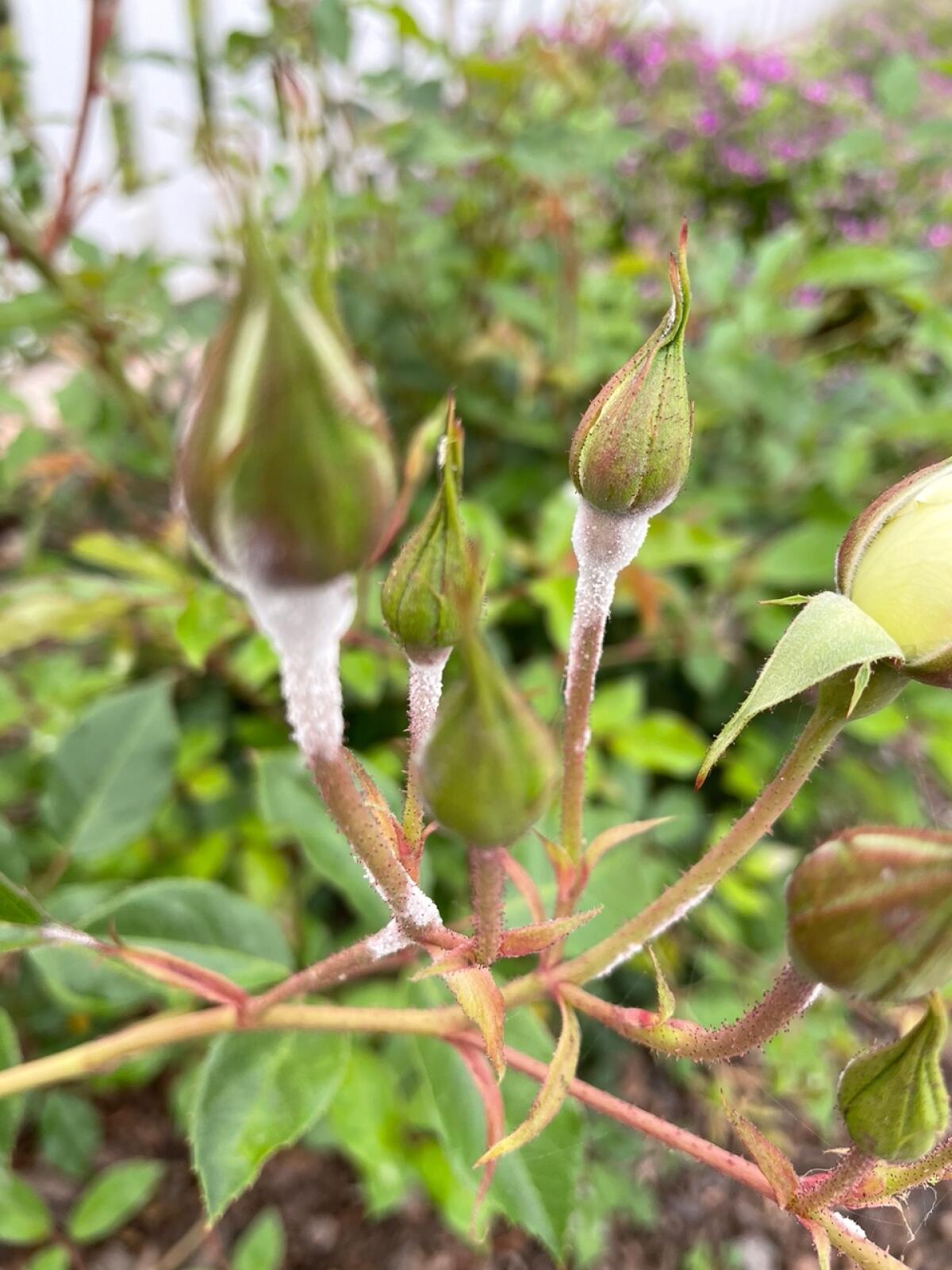
A fine, white powdery substance on the upper leaf surfaces of the youngest leaves, shoots, buds and sepals indicates that your rose has powdery mildew.
(Rita Perwich)
1. Powdery mildew caused by the fungal pathogen Podosphaera (Sphaerotheca) pannosa is often most active when cool nights are followed by warm, humid days and limited rainfall. This fungal disease does not require free water on the plant surfaces to develop, but it does need high humidity for spores to germinate. Spores are disseminated in air currents. The fungus overwinters in infected rose canes and in fruiting bodies found in leaf litter.
Management: Plant resistant cultivars, cut off and remove diseased foliage and buds from garden. The spore-release cycle can be disrupted by blasting newly infected leaves with water. Do this early in the day to allow foliage to sun-dry to prevent water-induced fungal diseases. Fungicides, if used, should be sprayed as a protectant before disease develops.
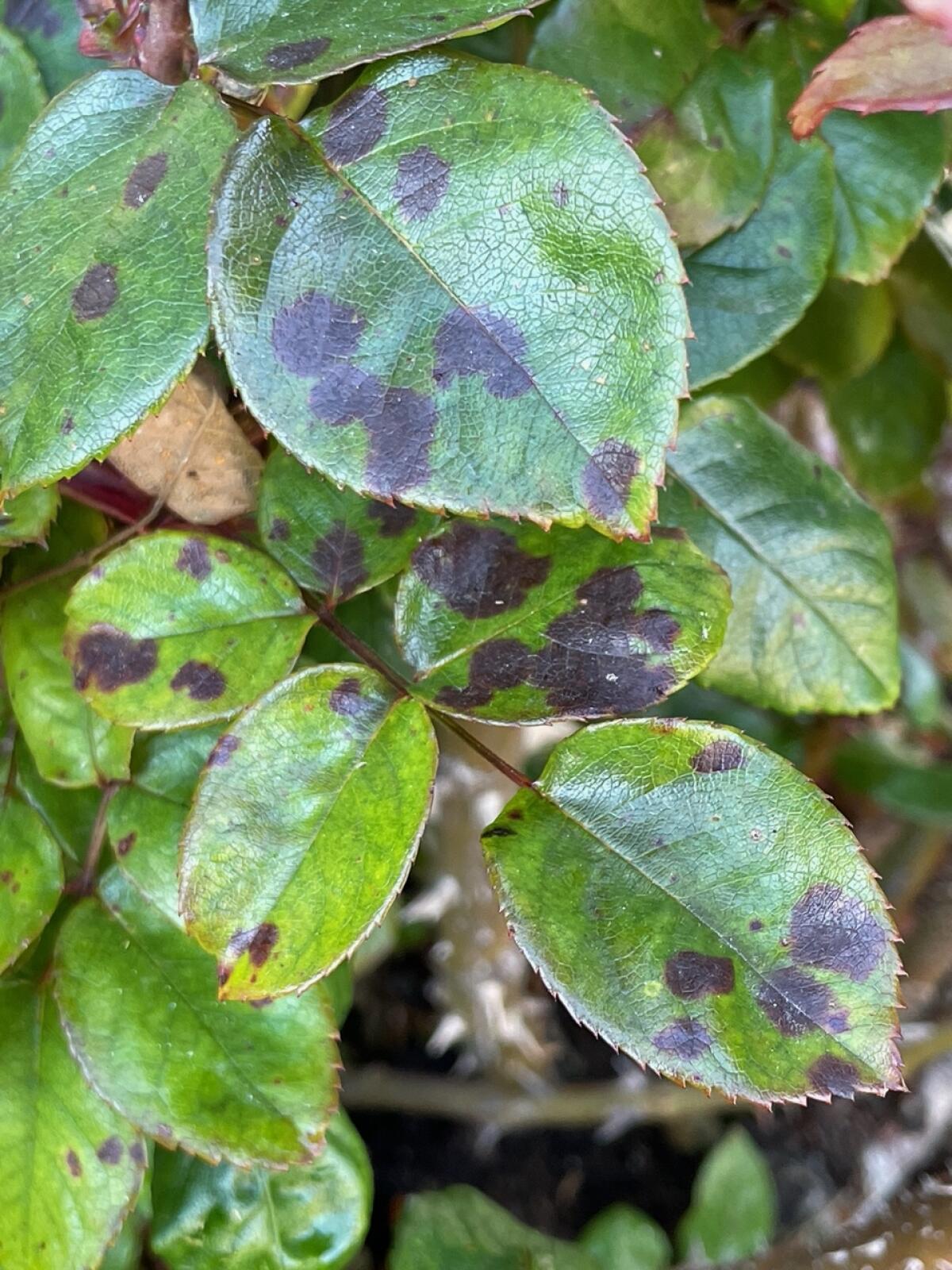
Black spot is a water-induced fungus with black feathery margins that is prevalent in wet weather. The black fruiting domes release thousands of spores and spread the disease to other susceptible roses.
(Rita Perwich)
2. Black spot caused by the fungal pathogen Diplocarpon rosae is a water-induced fungus. It is prevalent in wet weather or when there is high humidity or conditions like overcrowded plants that prevent foliage from drying. The spores require at least six hours of water to germinate and infect plants. Part of the life cycle of this fungus is entirely within the leaf. A week to 10 days later, black spot becomes a super spreader! Each of the small black fruiting domes releases thousands of spores, providing us with thousands of reasons why infected leaves should be removed from the garden. Fungi can survive on fallen dead leaves, so the source of an infection during this year’s rainy season is very likely the previous year’s spores splashing up and infecting leaves.
Management: Plant resistant cultivars. As with the other water-induced fungi, lessen humidity around plants by proper pruning, spacing and reducing wet foliage by using drip irrigation. Remove infected leaves on the bush and fallen leaves around the plant to reduce spreading disease to other susceptible roses. Fungicides, if used, are most effective if sprayed preventively. Since this pathogen is known to make genetic changes, it is important that if you decide to spray, rotate fungicides with different modes of action.
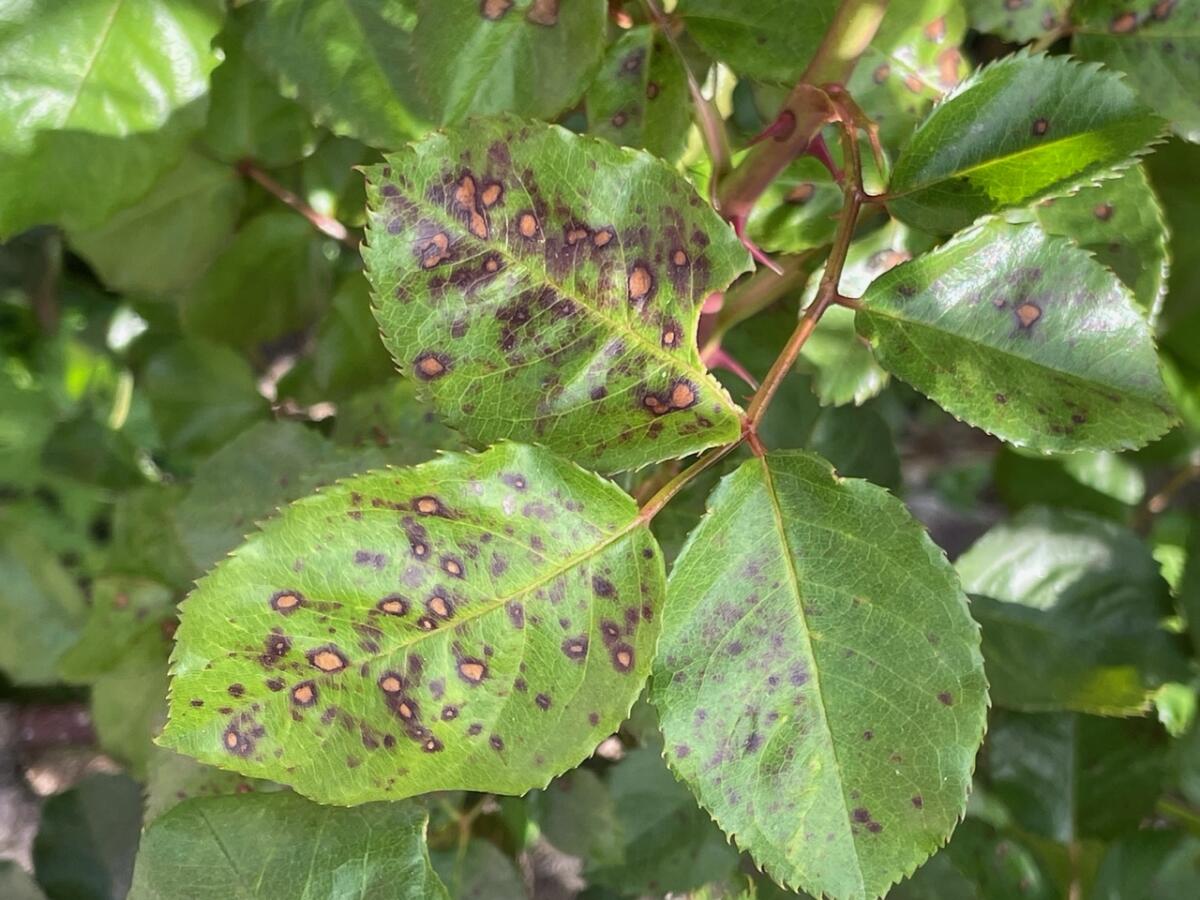
Anthracnose starts out as small reddish purple spots on the rose leaves. The centers of the spots will eventually turn a grayish or white color with a red margin ring around them. It is usually seen most often in the spring.
(Rita Perwich)
3. Anthracnose is a less common fungal disease caused by Sphaceloma rosarum. Spores are spread by splashing rain. The disease can move out of the leaf into the petiole and into the cane. This disease is seen most often in cool weather in late spring to early summer. ‘Neil Diamond’ is highly susceptible to anthracnose in the spring months but continues to grow and bloom vigorously even during the outbreak.
Management: Since this is a water-induced disease, space plants and use drip irrigation. This helps foliage stay dry, which slows the spread of the disease.
4. Rust is caused by the fungus Phragmidium mucronatum and P. tuberculatum. Rose rust is monoecious, meaning that it only has one host: roses. Rust is most prevalent in the western United States because very cold temperatures inhibit its survival. It is most severe in cool, moist weather, which makes it most common in coastal areas of San Diego and, in rainy years, inland. Rust grows only on live tissue but makes overwintering structures that survive in leaf debris. In the spring, spores blow or splash up onto newly emerging rose foliage and can germinate with conditions of as little as two to four hours of moisture.
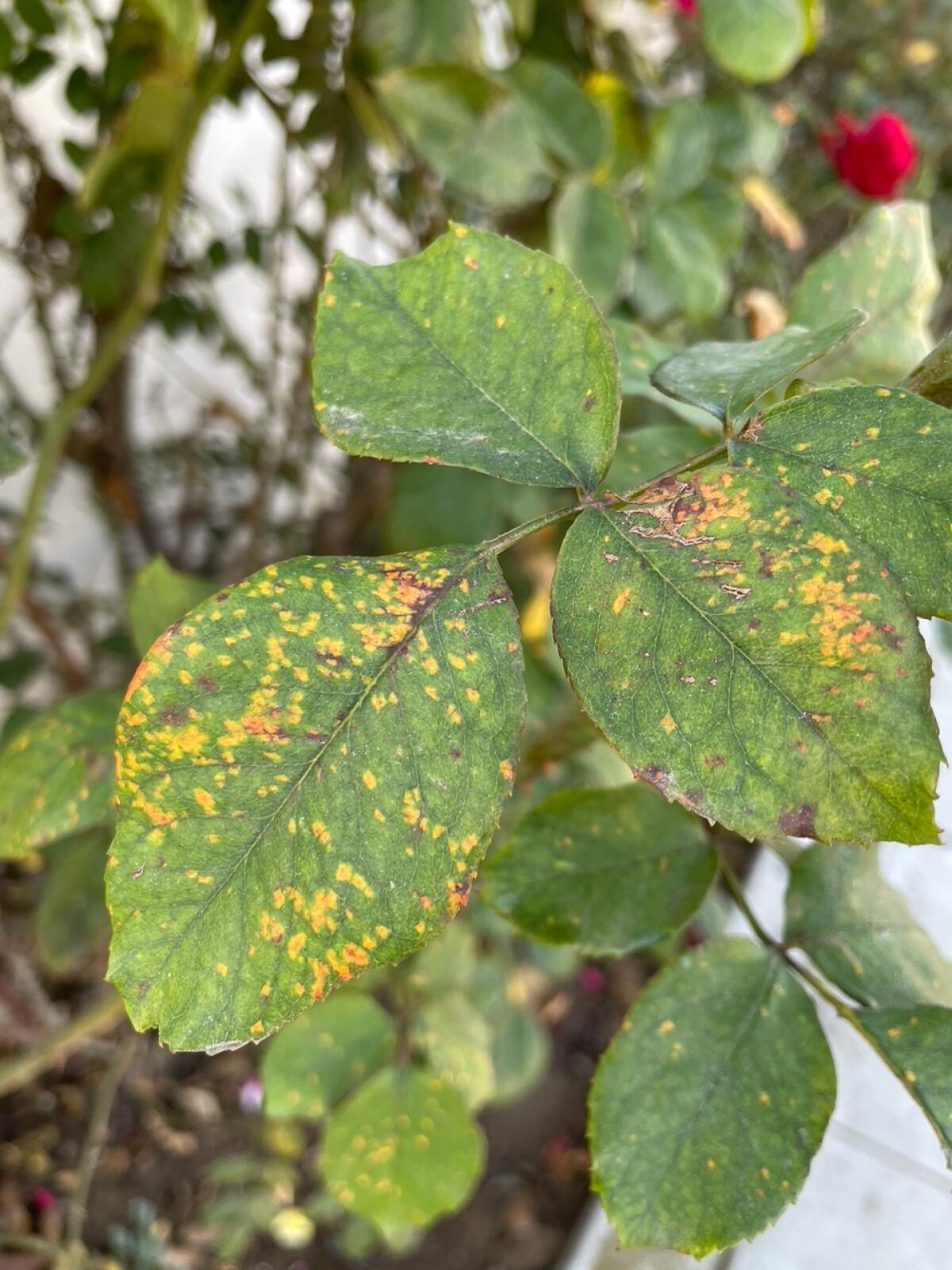
Orange pustules on the undersides of leaves, and faint yellow or orange spots on the top surface of the leaves make rust easy to identify.
(Rita Perwich)
Management: Plant resistant cultivars. Some cultivars tolerate rust, but intolerant cultivars can defoliate completely. Cut out leaves with rust pustules rather than pulling them off as the latter action disperses the spores onto other leaves, into the air and onto the soil. Removing fallen leaves is a must. Also, spread a thick layer of mulch. Do not compost leaves that have fungal disease. If you decide to spray, use a protectant fungicide.
5. Rose virus symptoms are line patterns and mosaics. These sometimes fade in the heat of the summer but return in cooler weather. Viruses cannot be spread to other roses. Sometimes the vigor of the rose is affected, and a rose may produce fewer blooms and shorter stems. Most viruses are disseminated not by pruning or by vectors but by the propagation of infected plants. The remedy is to inspect plants before purchasing and not buy symptomatic plants. Fortunately, rose rosette virus is not currently a problem in California. This lethal virus does kill infected roses and is transmitted by the eriophyid mite.
6. Botrytis blight is a fungal disease caused by Botrytis cinerea and is worst in cool, wet weather. It is most problematic in coastal areas in early spring and fall. You will notice gummy-soft, gray or brown edges on the petals of older blooms. Deadhead and remove infected blooms, as they cannot be salvaged. On multipetaled roses, the buds can become soggy and ball up. The next stage is a fuzzy gray mold that can release millions of spores and spread the disease to other as-yet uninfected buds and blooms.
Management: The remedy for botrytis is sanitation. Because the spores reproduce quickly and can infect other uninfected blooms, it is imperative to promptly remove affected blooms and fallen petals. Also, check and modify irrigation and curtail overhead watering. Space out plants and reduce companion plantings to increase air circulation and lessen humidity. Botrytis can live, nourish itself and multiply on live or dead plant material.
7. Ghost spotting is caused by several fungi including Botrytis, Bipolar, Cercospora and Cladosporium. The small pink spotting can be most severe during prolonged periods of rain and consecutive days of May gray, June gloom and high humidity.
Management: Affected blooms should be promptly deadheaded. Protective fungicides are of little use as they wash off with rain, and systemic fungicides are also ineffective because little fungicide accumulates in petals.
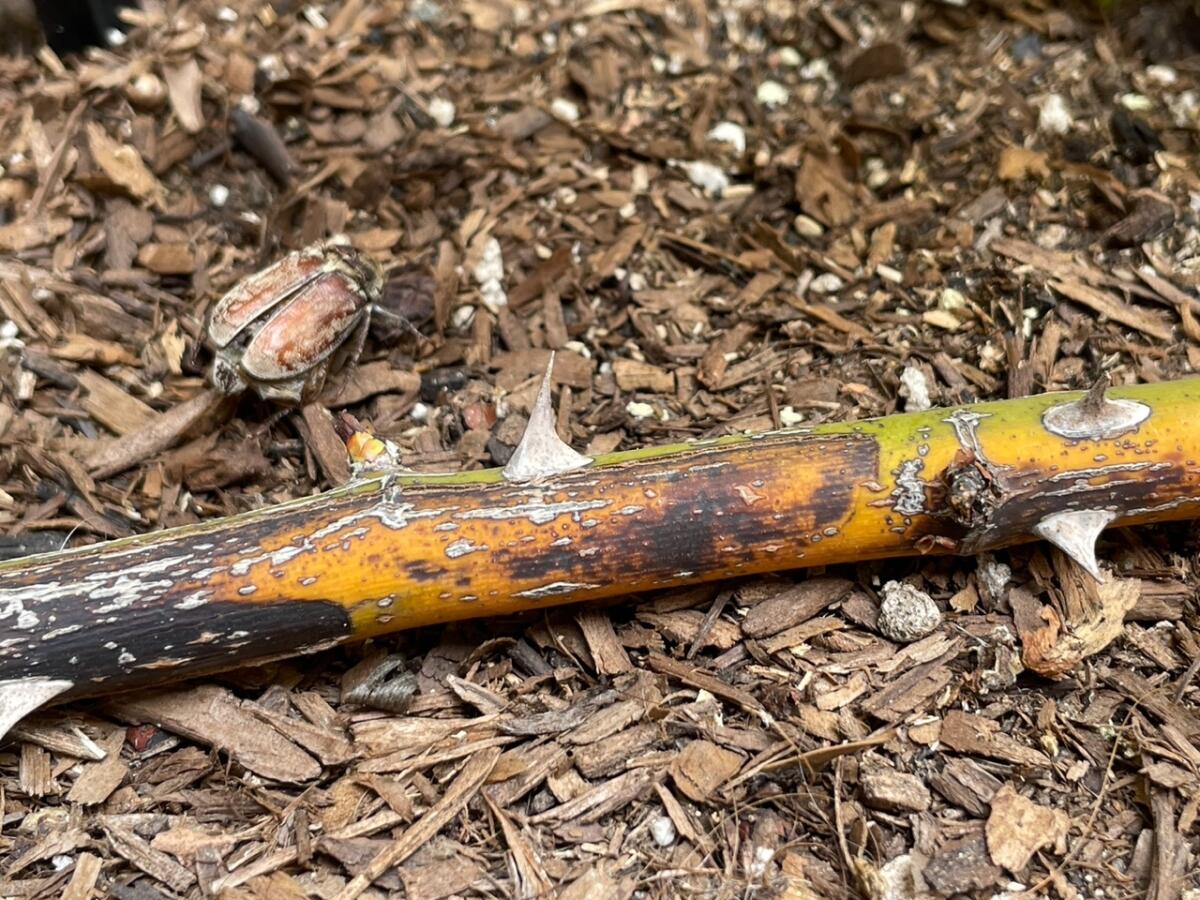
Blotchy, yellow or brown canes must be pruned out at least 2 to 3 inches below the infected portion.
(Rita Perwich)
8. Stem and cane cankers can be caused by several fungi. Diagnosis of the fungi or bacteria responsible is difficult because sometimes the fungal pathogen or bacterium found in the wounded cane is not the pathogen that caused the canker, but a secondary invader. Cankers are more likely to occur on plants that have been weakened by pest, disease, sunburn, poor nutrition or wounds, including pruning wounds, that open the inner cambium to disease.
Management: Fungal spores can start on blooms and leaves and move on to invade the canes, making it very important to remove any fungal-infected flowers and leaves from the garden. Cut out cankers as soon as they are detected, pruning at least 2 to 3 inches below the infected portion. Avoid wounding the cane, which allows penetration and infection by disease. Presently, Mark Windham is of the opinion that fungicides are not effective for management of cane disease.
The quiz is over, and now you are ready for the practical — in your garden.
Perwich is a member of the San Diego Rose Society, a consulting rosarian and a master gardener with UC Cooperative Extension.


